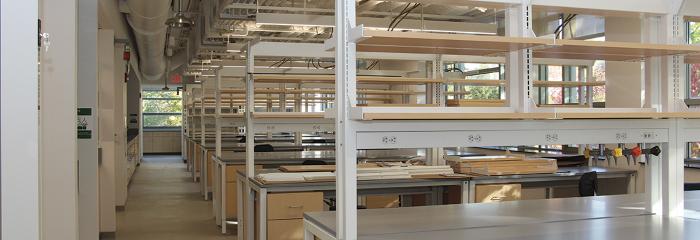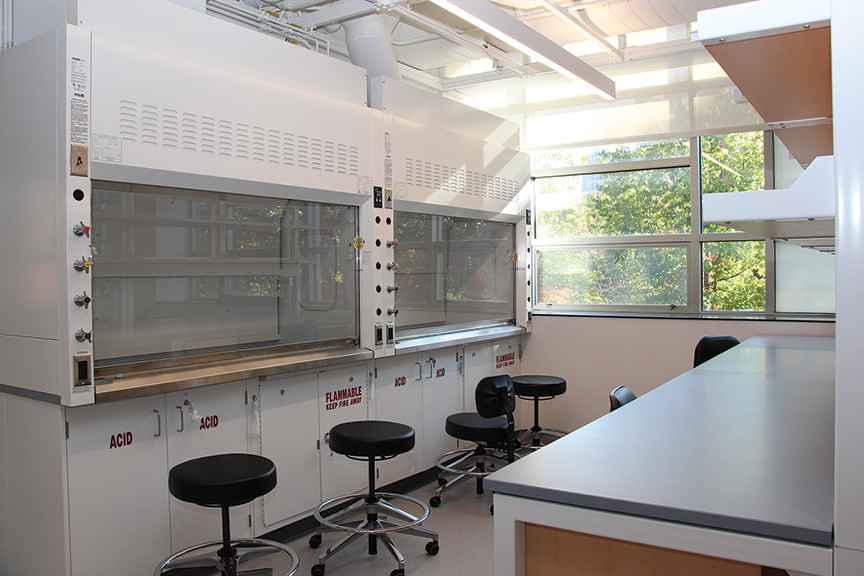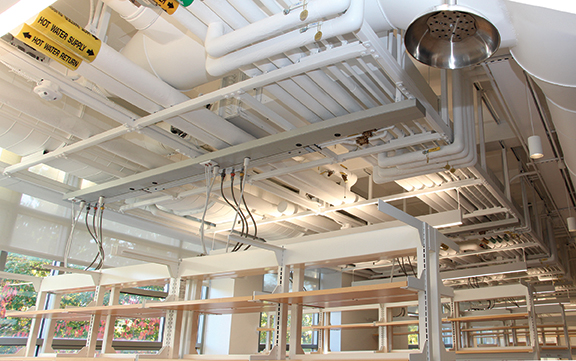
Inside the New Samuel C. Fleming Molecular Engineering Laboratories
By Chris Dawson
As an undergraduate at New York University and Stevens Institute of Technology, Chris Alabi was a self-described lab rat. “I worked as an undergraduate researcher in Professor David Schuster’s lab for four years,” says Alabi. “I basically lived there; I did all my homework in the lab. The lab was it, and everything else simply existed around the lab. It became my home.”
Now that he is an associate professor in Cornell’s Robert Frederick Smith School of Chemical and Biomolecular Engineering, Alabi is the one making undergraduate and graduate researchers feel like his lab is a home. His lab is in the north wing of Olin Hall in the newly created Samuel C. Fleming Molecular Engineering Laboratories. These labs are the result of a generous gift from Sam ’62 and Nancy Fleming.
Olin Hall had not had a major overhaul of laboratory space in more than 30 years, so the Fleming’s gift is very much appreciated by the three professors who now occupy the space. The 7,300 square feet of new labs is being used for research into drug design, drug delivery, biomedical diagnostics, and the discovery of new materials. The work done by Alabi and the other professors in the Fleming Labs covers all of these bases and more. Gathering them together in a dedicated space with shared resources and ease of contact and collaboration is a realization of Sam Fleming’s vision in giving the gift.
“The new space is really everything I hoped it would be,” says Alabi. “Compared to my old space, it gives us all a safer, cleaner atmosphere to work in, with our own house vacuum, nitrogen, and an autoclave and dishwasher for sterilizing glassware. Most importantly, the human element is huge. In the new space, our group now interacts with more people who are working on similar and disparate research and we are all able to learn from each other.”

When Alabi says “us” and “we,” he is talking about the postdocs, Ph.D. students, and undergraduates who are part of his lab. But he is also talking about Assistant Professor Rong Yang, Tisch University Professor Nicholas Abbott, and all of the other people in their labs, as well. All told, this “us” includes close to 50 people.
“It’s people that matter,” says Abbott. “I’ve always had an office that has been on the other side of the building from my research group. Now that we are all in one space it is so much easier to grab a couple of people and say ‘why don’t we try this together?’ Collaborations and exchanges of information happen much more frequently and naturally now that we are in the Fleming Lab space.”
Behind the name
The gift that catalyzed the Samuel C. Fleming Molecular Engineering Laboratories and all of these interactions inside came in the form of $10 million from Sam ’62 and Nancy Fleming. Sam Fleming earned his bachelor’s degree in chemical engineering from Cornell in 1962 and an M.B.A. from Harvard in 1967. He had a long and successful career focused on the analysis of biopharmaceuticals and the management of health care networks. Fleming served on the Engineering College Council and was on Cornell’s Board of Trustees and Weill Cornell Medicine’s Board of Overseers.
He and his wife Nancy also supported the university’s New Life Sciences Initiative. They endowed a professorship and three postdoctoral fellowships in the Weill Institute, and supported a fellowship to support collaborative research between the Ithaca campus and Weill Cornell Medicine. They also supported the McMullen Engineering Scholarship program, the Cornell Botanic Gardens, athletics and Greek life. The Fleming Molecular Engineering Laboratories was one of the last gifts to Cornell from Sam Fleming before he passed away in May 2019.
Fleming Lab research
“My lab uses a lot of customized instruments that we build ourselves,” says Assistant Professor Rong Yang, “and that required a significant modification of the HVAC and the venting and the flow rate of the gases coming in. So Abe and I really worked together on guaranteeing the new space would have what I need for my work.”
Abe, in this case, is Abe Stroock—the William C. Hooey Director of the Smith School. In an interview given as the Fleming Labs were still being constructed, Stroock said, “These faculty members represent a powerful cluster who truly engineer systems from the molecular scale. This laboratory space will allow them to continue to develop new chemical design principles, synthesize their own molecules and pursue a rich array of applications in biomedical and environmental contexts.”

Alabi examines how the composition and order of the building blocks of a macromolecular chain affect its chemical and biological properties. The long-term goal of his work is to assemble new, sequence-controlled macromolecules that can be used in a variety of ways. Alabi sees these designer macromolecules being used to quantify intracellular processes, to deliver drugs to specific areas of the body efficiently, and to act as a new class of powerful antimicrobial and antiviral agents.
Yang is thrilled to share lab space with Alabi and Abbott and sees many places where their research is complementary. Yang has several research focus areas. One is using polymer vapor deposition techniques to create surfaces that allow the manipulation of bacteria-surface interactions via nanometer-scale heterogeneities. In this way, she hopes to control the interaction between surfaces and bacteria. Another thread of Yang’s research is creating predictably uniform porous membranes for use in health care, water purification, and energy storage. A third focus of Yang’s lab is developing material-based antibiotic treatments that disinfect by converting secreted metabolic products of pathogens to antimicrobials in situ.
“My long-term, shoot-for-the-moon goal,” says Yang, “is to encode ‘orders’ for bacteria into the materials we create so that we can deploy bacterial biofilms for fouling prevention, disease treatment, and environmental preservation.”
“Cornell has a strong cluster of people who really care about the problem of antibiotic resistance and we enjoy working together to solve this problem,” says Yang. “The work I do in this area can benefit greatly from working in such close proximity to Chris and his group. And I am excited to work with Nick on material innovations at the molecular level, which could enable unprecedented material properties.”
“For me,” says Abbott, “this new lab space is a wonderful means to an end. I like science and I like engineering and I like exploring. I was very grateful to have the opportunity to help design the new lab. It’s going to let us discover, create and manipulate things at the molecular level in ways that have not previously been possible. And the proximity to Chris and Rong simply adds to those dimensions.”
In separate conversations with Abbott, Alabi, and Yang all three bring up the idea of trying to consciously create a community of people focused on the theme of the Fleming Labs space—molecular engineering. It is clear that this community is already well-established. Even while Olin Hall was closed during the COVID-19 shelter-at-home decree, lab groups continued to meet virtually to create grant proposals, discuss papers in progress, talk about research, and simply make contact.
The work done and the innovations created will benefit just as much from the abundant human interactions the new spaces facilitate as from the new utilities, capacities, and technical equipment now available.

